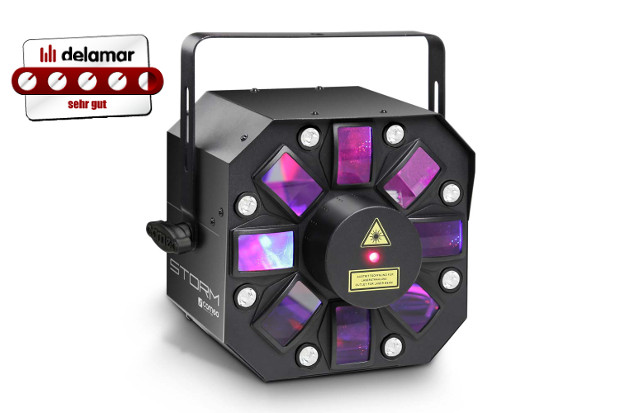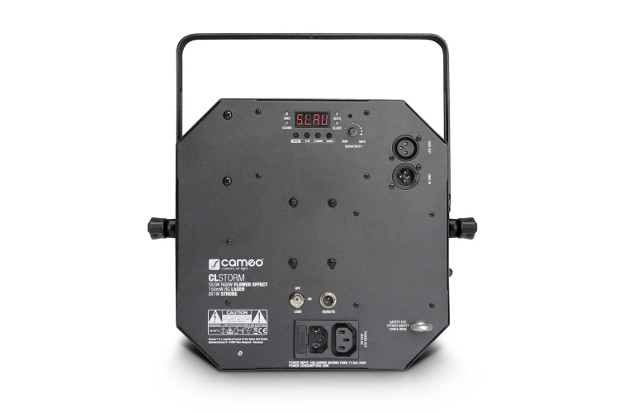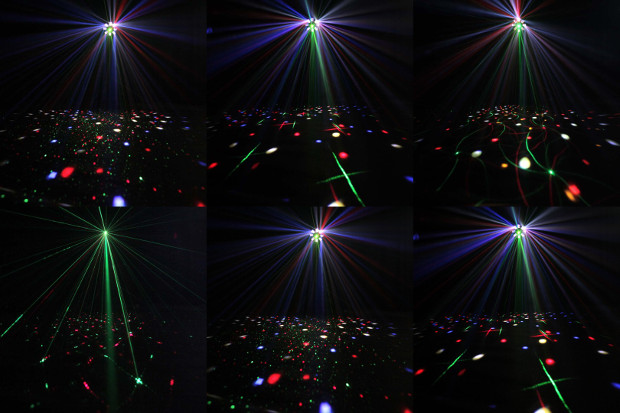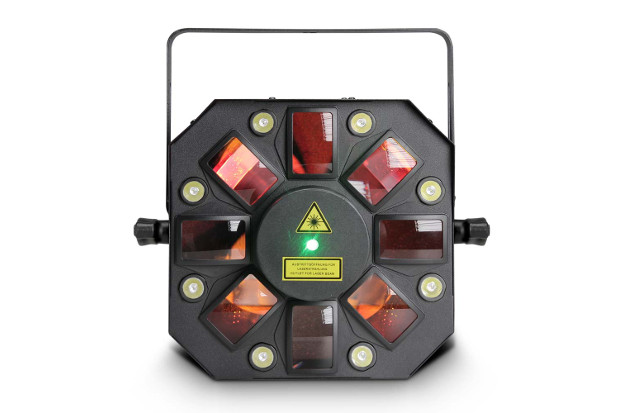Cameo Storm – Test report by Delamar.de
Three in a row – in the Cameo Storm Review you’ll find out how the 3-in-1 effect spotlights work in practice using LED technology. The combination of the Derby effect, strobe and laser lighting sounds very promising, so you can read all about processing, use, functionality right here, and of course, light and laser quality too.

What is it? The Cameo Storm combines LED effect spotlights and strobe and laser lighting to be used on stages and in clubs and discos. Unlike the previous Cameo Moonflower HP reviewed by delamar, separate LEDs have been installed for the stroboscopic effect here, which creates considerably more design options for your light show, especially in combination with the laser. You can control all the functions using the 10 DMX channels, meaning that even a simple DMX controller is sufficient to fully operate the Storm.
Cameo Storm Review
At 4 kg the stable and superbly finished Storm in black metal housing is both lightweight meaning that it neither burdens cross beams nor your muscles. The contents include an adjustable mounting bracket that can be screwed into the side of the housing without any tools, an adapter plug for the remote connection as well as a set of keys to lock the laser in the ON/OFF position. This is exemplary, as it means the laser cannot be accidentally activated, which would be hazardous if it were operated improperly. If the LOCK switch is set to OFF, the laser and the corresponding DMX channels are disabled.
The Storm has a RGBWA colour spectrum, so that you can also use Amber (yellow) for your light show in addition to the usual red, green, blue and white. These five LEDs all run on 3 watts each, thus there are 15 watts available for the expansive Derby effect, which is popular in disco dance floors due to its changes in colours and rotation effects.
There are eight white LEDs with 1 watt each located between the eight glass lenses on the front panel that the light from the LEDs penetrates. These are responsible for the separate strobe effect and can be controlled via a separate DMX channel. Unfortunately, they cannot be controlled separately, which would have created even more design options, but that would have significantly driven the DMX channel numbers and, ultimately, the price upwards.
There is a Grating laser based on a green and a red laser diode in the middle. The Grating laser projects different patterns on surfaces using a combination of motorised wheels and optical lattices and is therefore more versatile than a pure ray laser.
CAUTION: Laser beams from a certain wattage can cause serious damage to the eyes and to the skin. For this reason, a laser protection officer is required for the public use of class 3R, 3B and 4 lasers, who is responsible for the safe operation of the laser device. In addition, the operator of the laser has to inform the competent authorities about their use. Generally, you should never look directly into the laser aperture or the laser beam!
On the back of the Cameo Storm you’ll find the power and DMX connections (DMX In and DMX Out), the lockable LOCK switch and the connection for the optional remote switch for (de)activate the laser from a distance. The LED display is easy to read even in daylight, and the four buttons allow you to switch spotlight modes and set up the DMX start addresses.

Operation and effects The Storm also has a car and a music mode, each with seven programmes in variable speeds, a slave mode if you want to connect more Storm spotlights, and also lets you control over ten DMX512 channels. Our review focussed on the DMX mode, because we only had the full range of functions of the spotlight available.
Channel 1 hosts, as is to be expected, the dimmer used to control the brightness of the outgoing light. The dimmer works in a perfectly clean manner and allows you as a lighting designer to both create a linear fade-out as well as switching the lights on and off accurately in response to speech.
Channels 2 to 5 let you control the RGBWA LEDs of the Derby effect. 31 combinations of colours are possible – the Extra Amber LED is amazing! Both the speed of the colour change and the rotation of the internal mirror can be managed, and the Derby effect also has a strobe function. That’s a beautiful thing, as it means that you can use this widespread effect in all colours (not just for white).

You can create the full blinder effect (all LEDs on) just by using the separate strobe light made up of eight white LEDs on the front panel. In addition, you can control more than ten strobe programs using the eight circularly arranged LEDS, and you can also increase the speed of these. The strobe should flash up to 30 times a second according to the manufacturer’s specification. It’s hard to count, but testing it in practice has shown that it can perfectly create those typical choppy, slow-motion images on create dance floors and without any blur. That’s how a strobe light should work!
Three DMX channels are used to control the laser. I would have liked to have one or two additional channels here in order to control certain functions separately. Nevertheless, the laser works well. The first channel alternates between the red and green laser diode and lets you choose: Red or green laser, flashing red/green, red and green alternately or simultaneously flashing, etc.
The laser also has a strobe function that you can control the speed of via the second channel. The separate possibility of being able to create the laser via music is a very nice touch. This creates additional design options for your own light show. The third channel is used to select and control the pattern projected by the laser, as well as the rotation speed.
With a total of 150 mW, this laser overpowers its small number of competitors, but it also impresses not only with its diverse selection pattern, but also due to its a clean illustration of the same. Of course, each laser only reaches its full visual impact when combined with smoke and/or steam, but its powerful projection onto surfaces also means it can be used in “clean” dark rooms.
If it had a full RGB laser (including blue), then I would be totally sold. Since the human eye absorbs the colour blue significantly worse than it does green or red however, a RGB laser would require considerably more wattage. This would become considerably more expensive to manufacture.

Pros:
– Three effects in a single spotlight
– Lightweight
– Fully-fledged stroboscope
– Laser controlled separately via music
– Good value for money
Cons:
– More DMX channels for the laser would be desirable
– Operating volume
Cameo Storm review conclusion
Looking at the current selling price of 219 euros, Cameo need to be first congratulated for creating the Storm. Three full-featured lighting effects in a single housing give you a wide range of design options, especially due to the RGBWA. In addition, the performance is sufficient to be used in small clubs or on dancefloors. And a laser is always something special.
The only thing missing is a high operating volume. But, as it isn’t likely to be used in theatres or art galleries, the effect spotlights in all likelihood won’t need this. All in all, the Cameo Storm reviewed by delamar therefore earned a very good rating of 4.5 out of 5.
At a glance
Cameo Storm review summary: “An affordable solution for multi-coloured effects, jagged strobes and music-controlled laser light.”
Key features:
– 3-in-1 LED spotlights
– 5×3 W RGBAW Derby effect
– 150 mW Grating laser
– 8×1 W stroboscopic LEDs
– 10 DMX channels, music control and automatic
– Master and slave operation – Includes universal mounting bracket
– Ideal for: Event engineers and outfitters in small to medium-sized venues.
___________________________________________
Source: Delamar.de, April 2015, Germany: http://www.delamar.de/test/cameo-storm-testbericht/
Author: Alexander Cevolani
Learn more about Cameo Storm here:
http://www.cameolight.com/en/products/led-light-effects/storm-3-in-1-lighting-effect-5-x-3w-rgbaw-derby-strobe-and-grating-laser/
Leave a Comment
You must be logged in to post a comment.











